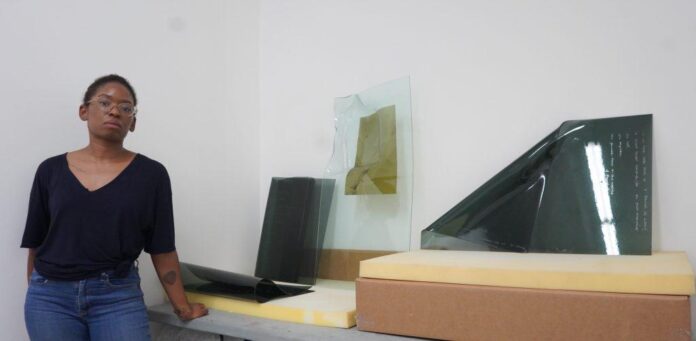The Houston-born, New York-based artist Charisse Weston’s work is not meant to be easy. Combining text, glass, collaged images and the like, it explores the “reticent poetics underlying Black life,” according to the Queens Museum, where her first solo institutional exhibition, titled “Of [a] Tomorrow: Lighter Than Air, Stronger Than Whiskey, Cheaper Than Dust,” opens October 2 (through March 5, 2023).
On the occasion of the show, we spoke with the artist about her use of glass, who she calls when she feels stuck on an artwork, and the latest Dia Foundation show she can’t stop thinking about.
Tell us about your studio. Where is it, how did you find it, what kind of space is it, etc.?
My studio is currently located in the same building as the New York Art Residency and Studios Foundation in Sunset Park. I found it through Listing Projects a few months ago. The size and pricing for the space is reasonable and I like that the studios are specifically for artists.
What are you working on right now?
Right now I’m installing my first solo museum exhibition at the Queens Museum, which opens October 2. It will include my largest site-specific installation to date.
I’m also working on two commissioned projects. One is for a museum in upstate New York and the other is a public art piece in collaboration with Houston-based artist Jamal Cyrus. The sculpture commemorates the late Texas senator Barbara Jordan. The outdoor, freestanding glass sculpture will be located at the African American Library at the Gregory School in Houston.
Lastly, I’m starting a fellowship at Bard Graduate Center, so I’ll also be doing more research on black archives of resistance, intimacy, and architecture.

A Charisse Weston work in progress, with glass panels being fabricated for the public art piece. Image courtesy Franz Meyer of Munich.
How many hours do you typically spend in the studio, what hours do you work, and what activities fill the majority of that time?
I don’t have a set number of hours I work in the studio. Because I do a lot of work with glass I normally use my studio more for staging work. For production, I primarily work out of Urban Glass where I was an artist in residence. I also work out of my apartment on none-glass work (my “Canvas” series, for example). The activities I am normally working on are writing, etching text, setting up the kiln, placing decals—lots of prep work.

Charisse Weston, (2022). Courtesy the artist.
Is there anything you like to listen to/watch/read/look at etc. while in the studio for inspiration or as ambient culture?
If I’m working out of my apartment I usually have the news on as background noise. If I’m in my studio I’m usually listening to audiobooks—I just finished Marlon James’s Moon Witch, Spider King and loved it. I can’t wait until the next installment.
What tool or art supply do you enjoy working with the most?
I enjoy using broken glass as a tool. I use it to etch onto the surface of photographs printed on canvas. Those works are part of an ongoing series entitled “Canvas.”

A detail, in-progress image of Charisse Weston’s , a diptych on canvas that will be on view at the Queens Museum this fall. Courtesy the artist.
How do you know when an artwork you are working on is clicking?
Usually I get a rush of excitement. I oftentimes take different components from one piece and try them out with others to see how it feels. I switch things around until I get that feeling that it’s right.
When you feel stuck while preparing for a show, what do you do to get unstuck?
This hasn’t happened to me yet in regards to preparing for an exhibition because I normally work in big bursts of production, which means for me that once the ideas are set I can make a lot of work without much hesitation. Sometimes individual pieces do give me pause though. When that happens I usually text a peer—or sometimes even my dad who I’ve worked with on project before—and ask them their opinion.

A work in progress. Courtesy the artist.
What’s the funniest thing that ever happened in your studio?
Once during a studio visit, a curator in L.A. told me my work was like someone took a peanut butter and jelly sandwich and put kale in it. He obviously meant that in a negative way—i.e., I was combining sculpture and text in a way that wasn’t easy enough for him to consume. Although it definitely pissed me off at the time to meet a curator unwilling to engage with a work of art in the terms they are given, it made me realize that I was moving in the right direction insofar as the complexity of the work and its materials should match the complexity of its subject matter (Blackness, interiority, and intimacy). Now whenever I tell this story I find the absurdity of the statement hilarious.
What’s the last museum exhibition or gallery show you saw that really affected you and why?
I went to see the exhibition “Camille Norment: Plexus” at Dia Chelsea a few months ago and it was superb. The use of sound/voice, material, and space is just so astounding to me. I’ve thought about that show quite a bit since I visited.

























